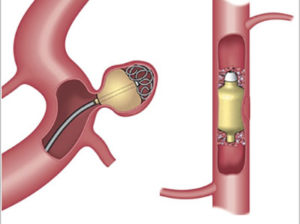 Metactive, an early-stage company focused on developing embolization devices for the treatment of peripheral vascular and neurovascular diseases, has announced the issuance of US patents 9,572,697 and 9,572,698 covering its Blockstent Microcatheter for embolization of peripheral arteries and veins and Ballstent Microcatheter for embolization of cerebral aneurysms. These proprietary microcatheter devices deliver a compressed gold metal implant over a 0.014” guidewire to treatment sites, where the implant is expanded and then detached to permanently stop blood flow.
Metactive, an early-stage company focused on developing embolization devices for the treatment of peripheral vascular and neurovascular diseases, has announced the issuance of US patents 9,572,697 and 9,572,698 covering its Blockstent Microcatheter for embolization of peripheral arteries and veins and Ballstent Microcatheter for embolization of cerebral aneurysms. These proprietary microcatheter devices deliver a compressed gold metal implant over a 0.014” guidewire to treatment sites, where the implant is expanded and then detached to permanently stop blood flow.
“We designed the Blockstent and Ballstent devices to provide an ideal solution for embolization. These devices are low profile, easy to use, and can quickly be placed with a high degree of precision, resulting in immediate, complete, and lasting cessation of blood flow,” said F Nicholas Franano, president and CEO of Metactive.
The new patents are part of an intellectual property portfolio that also contains numerous additional patent applications to which Metactive has exclusive rights in the US and major international markets. The portfolio covers four major patent families and includes methods of treating aneurysms, arteries, and veins, as well as related embolization devices.
Metactive also announced the closing of US$1.5 million of additional Series A financing, co-led by Mid-America Angels, with the participation of a family office and additional individual investors. Metactive previously raised $7.5 million in Series A funding, bringing the total funding raised to $9 million.
“This new funding provides Metactive with the resources to continue the development and testing of its novel embolization devices,” said Franano. “Our preclinical study results show that both devices routinely provide immediate, complete, and durable occlusion, something that market leading coils, flow diverting stents, and mesh vascular plugs cannot deliver. We look forward to a time when standing in the interventional suite wearing heavy lead protective garments, placing multiple devices, and performing serial angiography waiting for a vessel to occlude will no longer be required to complete an embolization procedure.”













